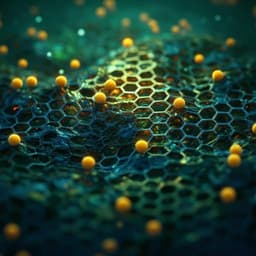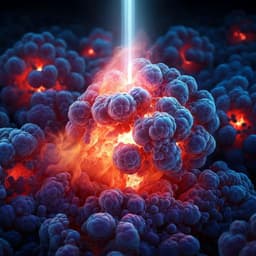
Chemistry
Enabling long-distance hydrogen spillover in nonreducible metal-organic frameworks for catalytic reaction
X. Bai, C. Yang, et al.
Discover how Xiao-Jue Bai, Caoyu Yang, and Zhiyong Tang have revolutionized hydrogen spillover in nonreducible metal-organic frameworks. Their study reveals how functional groups and water molecules enhance hydrogen migration, paving the way for efficient hydrogenation of N-heteroarenes with remarkable selectivity. This groundbreaking research could transform the landscape of heterogeneous catalysis and hydrogen storage!
~3 min • Beginner • English
Introduction
The study addresses how to enable and control long-distance hydrogen spillover on nonreducible supports, a long-standing challenge because hydrogen migration on such supports is typically defect-dependent and confined to short ranges. While reducible oxides (e.g., MoO3, TiO2) allow coupled proton–electron migration over long distances, nonreducible oxides (e.g., aluminosilicates, Al2O3) have shown limited, debated spillover. MOFs offer precise architectures and tunable chemistry as catalyst supports. The authors propose decoupling hydrogen activation (on encapsulated Pt) from hydrogenation (on MOF external surfaces) and modulating spillover via ligand functional groups or embedded water to achieve controllable, long-distance hydrogen migration without compromising MOF stability.
Literature Review
Prior work established thermodynamically feasible, long-distance spillover on reducible oxides via proton motion with concurrent electron transfer through the support framework. For nonreducible oxides, reports have long been controversial; a consensus has emerged that hydrogen mobility is defect-dependent and limited to very short distances. MOFs have been explored primarily for enhanced H2 adsorption via spillover, but studies on carboxylate-based MOFs (e.g., MOF-5) found short-range, thermodynamically hindered hydrogenation unless defects are present. In ZIF-8, thermoanalysis suggested spillover is confined near metal particles even at elevated temperature, resembling nonreducible oxides. A recent report claimed water-assisted long-range spillover in Pt@MOF-801 but with concurrent MOF collapse, obscuring mechanism and migration distance. These gaps motivate strategies to promote or restrain spillover in MOFs while preserving structure and to regulate migration distances for catalysis.
Methodology
- Stability and reduction behavior: Thermogravimetric analysis (TGA) under flowing H2 compared reducible MOFs (Cu-MOF-2, Fe-MIL-101, Co-ZIF-67) and nonreducible MOFs (Zr-UiO-66, Zn-ZIF-8) and their Pt-loaded counterparts (MOFs/Pt). XRD and XPS verified metal node reduction in reducible MOFs.
- Model catalyst construction: Synthesized sandwich nanocubes Zn-ZIF-8@Pt@Zn-ZIF-8 by adsorbing ~3 nm PVP-stabilized Pt nanoparticles onto ~100 nm Zn-ZIF-8 cores followed by epitaxial growth of outer Zn-ZIF-8 shells. XPS depth profiling confirmed full Pt encapsulation by the outer shell. Outer shell thickness tuned from 15 to 50 nm as a ruler for spillover distance.
- Postsynthetic ligand exchange/reduction: Replaced 2-methyl groups with functional groups CHO, OH, NO2, NH2 to obtain Zn-ZIFs@Pt@Zn-ZIFs homologs. Preservation of morphology/crystallinity verified by TEM and XRD; functional group incorporation confirmed by ATR-FTIR; 1H NMR indicated >85% linker replacement.
- Spillover evaluation via size-sieving hydrogenation: Leveraged ZIF-8’s 0.34 nm aperture to block large reactants (e.g., cyclooctene, 0.6 nm) from internal pores. Thus, hydrogenation occurs only on external MOF surfaces by spillover hydrogen. Measured cyclooctene hydrogenation under varied shell thickness, temperature, and time to quantify spillover intensity (conversion/100). Established linear relation of spillover intensity vs shell thickness (y = a x + b) and defined spillover decay factor a.
- Isotope tracing: Deuterium labeling (H2/D2 and H2O/D2O) experiments tracked hydrogen trajectories by GC-MS, distinguishing water-assisted proton exchange and functional group-mediated migration.
- In situ spectroscopy: Conducted in situ Zn K-edge XAS (XANES/EXAFS) and combined XRD under H2 at 80 °C to probe Zn oxidation state/coordination and structural stability. In situ XPS monitored Zn 2p, N 1s, and O 1s shifts to identify binding sites for hydrogen on functional groups.
- Visual probe: WO3 color-change tests assessed hydrogen spillover dependence on shell thickness and functional groups.
- Theory: DFT (VASP, PBE-GGA, PAW, 520 eV cutoff, Γ-point) with CI-NEB investigated hydrogen adsorption and migration barriers on Zn-ZIF-8, water-assisted proton hopping, and functional group pathways (aldehyde, nitro). Implicit solvation (VASPsol) evaluated water environment effects.
- Catalytic application: Selective hydrogenation of 5-chloroquinoline (size-excluded from pores) using Zn-ZIFs@Pt@Zn-ZIFs (-CHO and H2O) compared to Pt/C, Pt/TiO2, and Pt/Al2O3 at 2 MPa H2, 100 °C. Also examined dependence on shell thickness. Reaction protocols included standardized Pt amounts (cyclooctene: 0.004 mmol Pt, 80 °C; 5-chloroquinoline: 0.002 mmol Pt, 2 MPa H2, 100 °C, 120 min).
Key Findings
- Reducible vs nonreducible MOFs: In H2, Pt-loaded reducible MOFs (Cu-, Fe-, Co-based) decompose at lower temperatures than pristine due to spillover-driven hydrogenolysis and metal reduction (e.g., Cu-MOF-2/Pt T_w65 = 323 °C vs 386 °C; ΔT_w65 ≈ 63 °C). Nonreducible Zr-UiO-66/Pt and Zn-ZIF-8/Pt showed no spillover-promoted decomposition; frameworks remained stable.
- Long-distance spillover enabled in nonreducible MOFs: Pure, water-free Zn-ZIF-8@Pt@Zn-ZIF-8 shows negligible spillover below 100 °C, but embedded water or specific functional groups (OH, CHO, NH2) markedly promote spillover hydrogenation of cyclooctene on external surfaces. Water-containing samples show highest activity; activity of water-mediated catalyst decreases upon water loss.
- Quantification of spillover distance: Spillover intensity vs shell thickness follows y = a x + b. At 80 °C for 80 min, Zn-ZIF-8@Pt@Zn-ZIF-8 (H2O) exhibits the smallest decay factor a = 0.01997 and supports spillover exceeding 50 nm—unprecedented for nonreducible supports. Pt particle size (3 vs 5 nm) affects activation rate but not spillover decay factor.
- Kinetics: Initial zero-order kinetics across catalysts enabled Arrhenius analysis. Extracted activation energies (Ea): 37.37 kJ/mol (H2O), 39.98 kJ/mol (OH), 51.14 kJ/mol (CHO), 55.81 kJ/mol (NH2), indicating favorable low-temperature pathways.
- Isotope labeling: No H–D exchange on cyclooctene without Pt. Complete spillover hydrogenation/deuteration observed in water-containing systems (H2O–H2 and D2O–D2). Mixed H2/D2O or D2/H2O produce H-, D1-, and D2-cyclooctane, evidencing water-assisted proton exchange during diffusion. CHO-functionalized MOFs enable D migration across MOF (D2-cyclooctane detected).
- In situ spectroscopy: Zn K-edge XANES/EXAFS and XRD show unchanged Zn oxidation state, coordination, and framework under H2 at 80 °C, indicating spillover proceeds without metal node redox. In situ XPS reveals O 1s shift for CHO groups, identifying aldehyde oxygen as H-binding sites.
- Theory: Direct H atom migration on Zn-ZIF-8 carbon sites is energetically prohibitive (~1.5–1.61 eV). Proposed mechanism involves electron transport along the framework coupled with proton hopping. Water chains enable low barriers: ~0.2 eV (proton relay) or 0.66 eV for H3O2-mediated paths, rationalizing high activity and deactivation upon water loss. Aldehyde pathway: O–H–O hopping barrier 0.47 eV; nitro pathway barrier 0.86 eV, consistent with lower activity of NO2-functionalized MOFs.
- Catalytic application: For 5-chloroquinoline (size-excluded), Zn-ZIFs@Pt@Zn-ZIFs (-CHO and H2O) achieve high activity comparable to Pt/C, Pt/TiO2, Pt/Al2O3 but with >99% selectivity to 5-chloro-1,2,3,4-tetrahydroquinoline, minimizing over-hydrogenation and dehalogenation. Increasing shell thickness decreases conversion while maintaining selectivity, consistent with spillover distance decay.
Discussion
The study resolves how to induce and control hydrogen spillover over long distances in nonreducible MOFs without structural degradation. By constructing MOFs@Pt@MOFs sandwich catalysts that decouple hydrogen activation (on Pt) from hydrogenation (on exterior MOF surfaces) and by introducing mobile water or specific functional groups as proton relays, the authors enable substantial spillover distances (>50 nm) at low temperatures on Zn-ZIF-8, a nonreducible MOF. Spectroscopy rules out metal node redox during spillover, and DFT supports a proton-hopping/electron-transport mechanism with low barriers for water and aldehyde pathways. This mechanistic control translates to practical catalysis: selective hydrogenation of bulky N-heteroarenes occurs exclusively via spillover hydrogen, delivering very high chemoselectivity (>99%) while preserving halogens. The work highlights MOF modularity (linker functionality, water content, shell thickness) as handles to tune spillover distance and reactivity, offering a generalizable strategy to design size- and site-selective hydrogenations by spatially separating activation and reaction sites.
Conclusion
The authors demonstrate that while reducible MOFs undergo spillover-induced reduction and framework collapse under H2, nonreducible Zn-ZIF-8 can be engineered to support long-distance hydrogen spillover when assisted by embedded water or functionalized linkers (e.g., CHO, OH, NH2). A linear decay model quantifies spillover vs shell thickness, revealing distances exceeding 50 nm at 80 °C. In situ XAS/XRD/XPS and isotope studies show spillover proceeds without Zn redox, consistent with a proton-hopping mechanism along water chains or O-containing functional groups, corroborated by DFT energy barriers (0.2–0.47 eV). This controlled spillover enables highly selective hydrogenation of 5-chloroquinoline (>99% selectivity) by confining reactions to MOF external surfaces. Future work can extend this approach to diverse MOF platforms, optimize functional group chemistry and water management, and apply controlled spillover to other challenging, stereoselective hydrogenations requiring long-distance hydrogen delivery.
Limitations
- Water dependence: The highest spillover intensities rely on embedded water; catalysts lose activity upon water loss despite retained structure, indicating sensitivity to pore water content.
- Reducible MOFs instability: For reducible MOFs, spillover causes metal node reduction and framework damage, limiting their utility as supports under H2.
- Distance estimation model: Spillover distance is inferred from shell-thickness-dependent activity and a linear decay model (y = a x + b), not by direct imaging; assumptions in this model may affect quantitative distance estimates.
- System scope: Detailed mechanistic validation and long-distance spillover are shown primarily for Zn-ZIF-8 and its functionalized derivatives; generality to other nonreducible MOFs requires further verification.
- Temperature and conditions: Key demonstrations are at relatively mild temperatures (≤100 °C) and specific pressures; behavior under broader industrial conditions was not explored.
Related Publications
Explore these studies to deepen your understanding of the subject.







